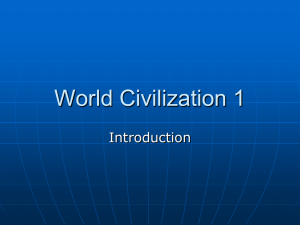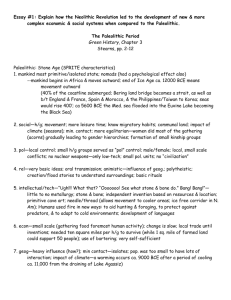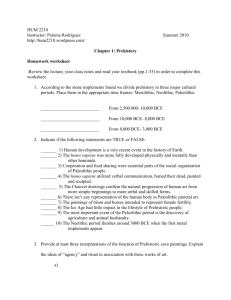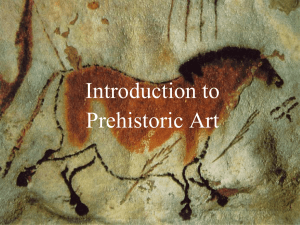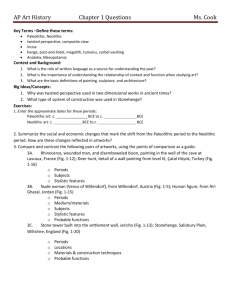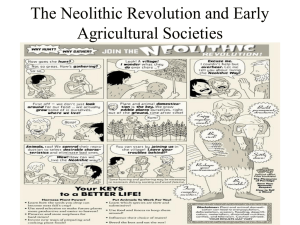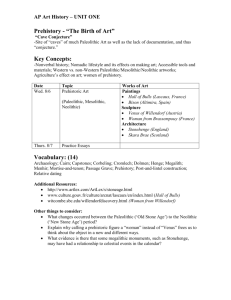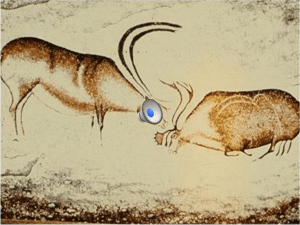ART02 - Prehstoric - SOA Literary Arts
advertisement
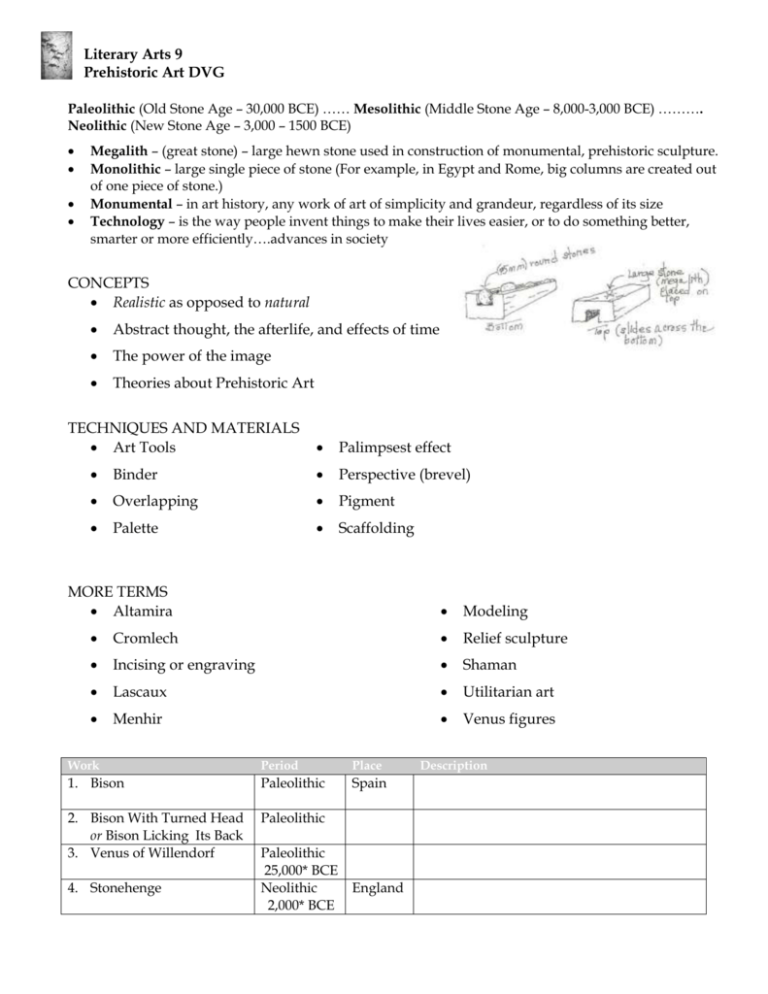
Literary Arts 9 Prehistoric Art DVG Paleolithic (Old Stone Age – 30,000 BCE) …… Mesolithic (Middle Stone Age – 8,000-3,000 BCE) ………. Neolithic (New Stone Age – 3,000 – 1500 BCE) Megalith – (great stone) – large hewn stone used in construction of monumental, prehistoric sculpture. Monolithic – large single piece of stone (For example, in Egypt and Rome, big columns are created out of one piece of stone.) Monumental – in art history, any work of art of simplicity and grandeur, regardless of its size Technology – is the way people invent things to make their lives easier, or to do something better, smarter or more efficiently….advances in society CONCEPTS Realistic as opposed to natural Abstract thought, the afterlife, and effects of time The power of the image Theories about Prehistoric Art TECHNIQUES AND MATERIALS Art Tools Palimpsest effect Binder Perspective (brevel) Overlapping Pigment Palette Scaffolding MORE TERMS Altamira Modeling Cromlech Relief sculpture Incising or engraving Shaman Lascaux Utilitarian art Menhir Venus figures Work Period Place 1. Bison Paleolithic Spain 2. Bison With Turned Head or Bison Licking Its Back 3. Venus of Willendorf Paleolithic 4. Stonehenge Paleolithic 25,000* BCE Neolithic 2,000* BCE England Description Great Stuff and Junk Hidden Landscapes Project Mental attributes associated with the creation of art - mental conception of an image, intent to communicate, and attribution of meaning to an image. Each of these abilities existed separately in the mind of Neanderthals, as indicated by the tools they made, their communication system, and their ability to interpret animal tracks – but they could not be combined. Artistic ability only emerged as a product of the cognitive fluidity of the modern human mind. In 1620 Duke of Buckingham had his men excavate right in the center of the monument. Subsequent digs destroyed prehistoric features. There was no “treasure.” Why do humans give so much time, thought, and prestige to make-believe in the world of books, movies, and visual art? Dutton (professor at Canterbury) explains how the arts became a universal and crucial aspect of human behavior; integrating philosophy, art theory, and common sense to build a solid argument that our “art instinct” evolved in the Pleistocene as risk-free way to test situations, pass on information, and display fitness and intelligence. The infinite life of the arts is sparked by faith; an unchangeable essence, regardless of wars, interruptions, or neglect. The arts outlive governments, dogmas, and the cultures which produce them. Because they are the essence of reality they cannot be totally destroyed. They are the true historians – all that is left when the dust and ruins are cleared away.” The Art Instinct by Denis Dutton Found in the fissure of a cave in the Caucasus; a 30,000 BCE knotted and dyed (red, black, turquoise, and violet) piece of a textile. Smithsonian 11/2009 He who works with his hands is a laborer. He who works with his hands and his head is an artisan. But he works with his hands, his head and his heart is an artist. Author unknown In 1780 John Adams wrote a letter to his wife saying: “I must study politics and war that my sons may have liberty to study mathematics and philosophy. My sons ought to study mathematics and philosophy, geography, natural history and naval architecture, navigation, commerce and agriculture, in order to give their children a right to study painting, poetry, music, architecture, statuary, tapestry and porcelain.” “Art washes from the soul the dust of everyday life.” - Picasso “The world is but a canvas to our imaginations.” - Thoreau It was thought that first stones were erected around 26000 BCE but we know now that centuries of activity occurred before. Geophysicists have made the first detailed underground survey of the area surrounding Stonehenge (totals more than 4 sq. miles). They developed software to process the 40-50 gigabytes of raw data. Mapped variations in the earth’s magnetic field. New radiocarbon dating techniques. GPS-guided versions that scan pinpoint discoveries to within on centimeter. Ground-penetrating radars that scan the ground to detect structures yards below the surface produce a three-dimensional photograph of the area. Found 15 unknown Neolithic monuments: henges, barrows, segmented ditches and pits. Was Stonehenge a temple, parliament, a healing ground, or graveyard? People traveled hundreds of miles to visit it….why? There is evidence for complex liturgical movement …..it is a ‘theatrical” way along the line of sunrise of the summer solstice…..Jerusalem Syndrome: the feeling of intense emotion experienced by pilgrims on first sighting of the Holy City. A New View of Ancient Ground Subterranean Features Detected by the Stonehenge Hidden Landscapes Project Smithsonian.com September 2014

